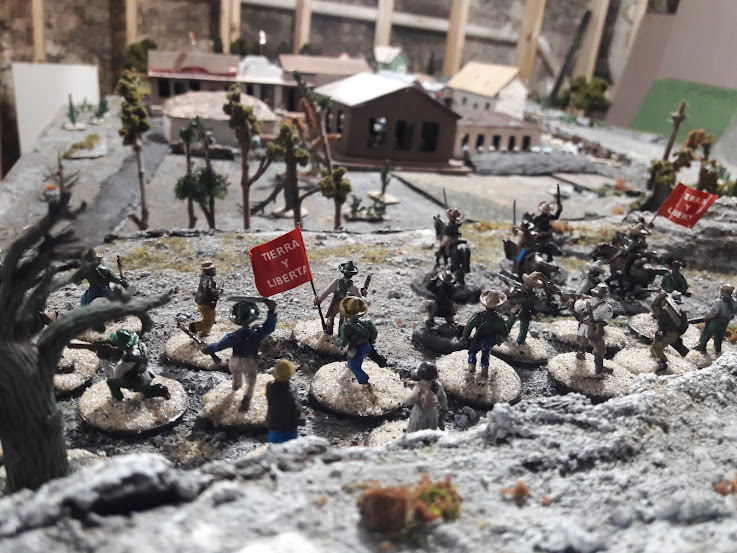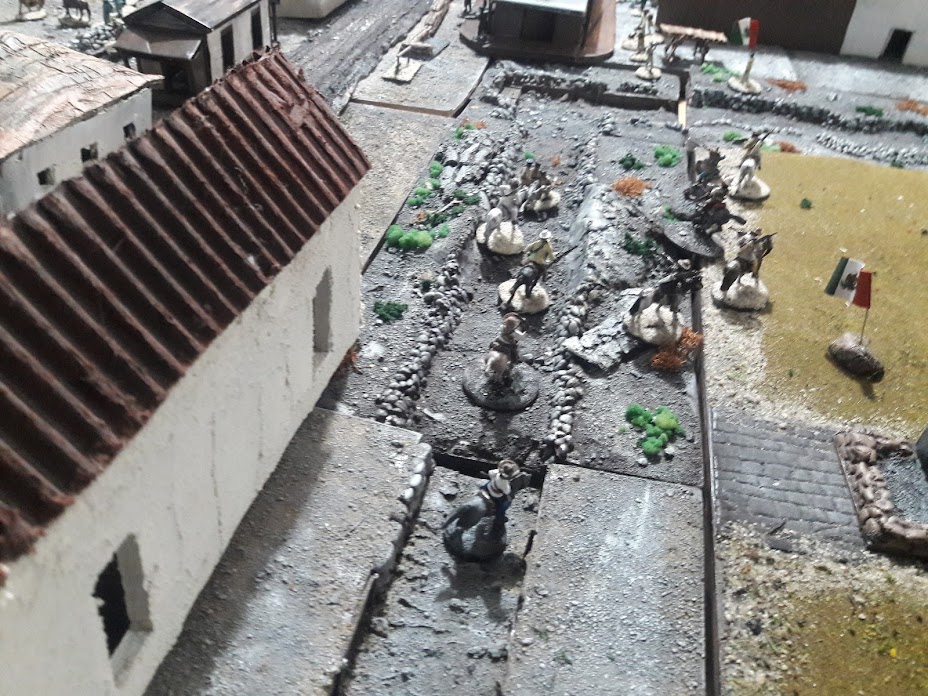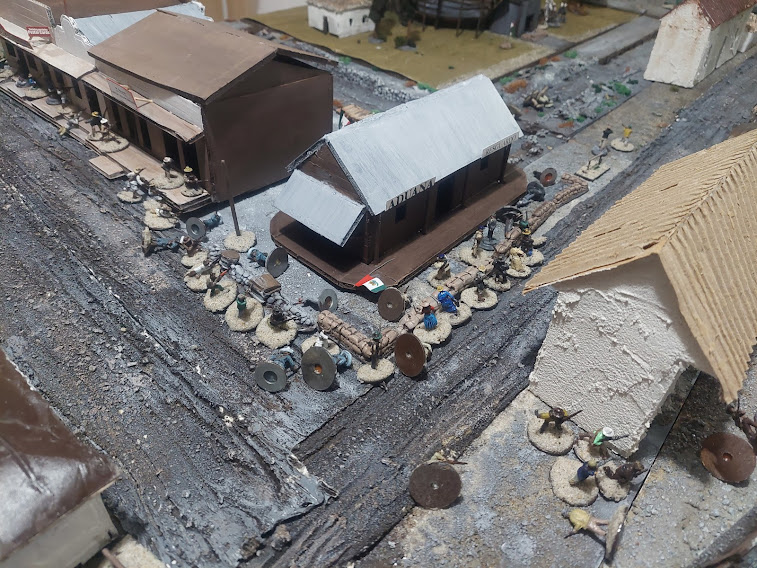Here is an after action report for Scenario 12: The First Battle of Tijuana, May 8, 1911.
This battle, fought on May 8th and 9th of 1911, saw the Foreign Legion (or Second Division) of the Liberal Army of Baja attacking the small border town of Tijuana. Though they had in fact been ordered to march in the opposite direction, the Foreign Legion's victory at Tijuana brought wide attention, especially in English-speaking media, to the Liberal cause in Mexico.
Here is a view of the table, facing north. The far end of the table represents the border with the United States.
Here is a view of the town, facing south. I placed the defenders' command post by the bull ring, behind the two defensive lines.

Here is the main section of town. The Federal soldiers' platoon had their headquarters there in the post office next to the Bazaar Mexicano, and the Rurales headquarters was across the street in the restaurant.
The defenders had a formidable, eastern-facing line, held by conscripts and other militia. On the street behind them, a mounted unit of civilians, and Rurales and Customs officers stood at the ready.
The second line of defenses consisted of a trench dug around the bull ring. The trench, empty except for a machine gun, would be the fall-back position for the defenders. Larroque and the general HQ set up at the bull ring.
The defenders had a second machine gun, in a forward position, guarding the south-eastern entrance to town. The Rurales section covered the south-facing line, with their headquarter section in the restaurant in the center of the southern line.
The attacking force, the Second Division--or Foreign Legion--of the Liberal Army in Baja, arrived from the south. First on the table was the first column of 85 rebels, divided into a few separate sections. The first section, a cavalry group, arrived on the eastern edge of the table, and had orders to race down the flank to lengthen the line the government forces needed to defend, and pull defenders away from the main target for the attack. The second section, a group of rebels on foot on the road, had orders to support the first cavalry.
Up on the hill, a second cavalry section waited in reserve, behind Pryce's mounted headquarters group.
On the left flank, the second section of infantry prepared to descend the hill and attack the southwest corner of town.
This was the view over the second section's shoulders, as they set off to begin the First Battle of Tijuana.
On the right flank, the first cavalry advanced as planned, racing down the river bed. The first infantry section followed behind them. As the rebels crossed in the open, the Federal machine gun fired at them, but the range was too faro cause any damage.
The second infantry section also came under fire. The line of Rurales behind the breastworks haulted the rebels' advance, and Pryce's comrades took cover where they could.
They did not return fire, however, because the rebel ammunition supplies were quite low to begin with, and it was no use firing at such a range at targets behind hard cover.
To begin the second round, Pryce and the PLM command was able to call up the second column, consisting of 60 rebels, split into two infantry sections (one to each side of the photo, below).
Ahead of them, their comrades, caught in the open on the edge of the hill, took fire and lost the first casualties of the game.
On the eastern edge of the table, the cavalry in the river lost a rider as well.
Conscripted citizens and soldiers at a machine gun had fired on the cavalry from the first line of defense, and they kept up the barrage each round.
The rebel cavalry, however, remained in formation. By the end of round two, the infantry section arrived to support them.
Up on the hill, the rebels in the open continued to take losses. Two more fell dead not far from Pryce's command post. The infantry section from the first column remained pinned down by the fire from town, and the second column's first infantry section refused to follow their orders and charge down the hill.
Perhaps sensing that the attack was stalling before it began, the Federal platoon decided to charge out of town and try to chase off the insurrectos. They rushed for the cover of a small hill, approaching the larger hill from which the attackers came.
The first sections of rebel cavalry and infantry, forming a line in the ravine, unloaded their opening salvos at the soldiers before them.
Though the range was long, the insurgents managed to kill five of the soldiers.
After they unloaded their weapons, the cavalry group raced up the eastern edge of the table. The conscripts facing them failed to fire that turn.
The infantry group in the river bed, after firing on the soldiers, crept up into better positions.
A group of them headed for the woods, east of the small hill, hoping they could get close enough to pick off the counterattacking soldiers, without exposing themselves to the defenders at the ramparts.
The soldiers fired their weapons at the rebels exposed on the top of the large hill, killing a few more. Then they continued forward, looking for over behind the second hill and the trees around it.
The Federal counterattack seemed to have some momentum, until Pryce sent the entire second column rushing forward. This time, both sections carried out their orders. The first section charged down the mountain at the southwest corner of town.
The second group from the second column moved to halt the advance of the Federales' platoon. They marched to the northeastern edge of their hill, and, face to face, traded shots with the soldiers.
The soldiers were now trading fire with rebel infantry to their front and to their left. While they killed some rebels, they were hopelessly outnumbered, and dwindling. They became pinned down behind the smaller hill.
Accurate shooting (good rolls) on the part of the rebels hit more than half of the Federal soldiers, including the platoon's officers. The soldiers fled back to town, while the rebels advanced on both sides.
On the west side of the table, the government's conscripts finally pulled themselves together. They fired a volley at the PLM cavalry in the river.
Three of the horsemen fell into the Rio Tijuana, but the cavalry section held together.
The riders returned fire, dropping two of the defenders. The cavalry then galloped forward, hoping to pull defenders away from the main assault. The Lerdo González, overseeing the western line from the Customs office, ordered the mounted security officers to chase after the rebel cavalry.
Meanwhile, the few surviving federal soldiers struggled to reach friendly lines as the insurrectos charged the town.
The defenders were well dug in, and fired at the advancing rebels from behind the breastworks, but Pryce had engaged three infantry sections, and they pressed the southern line from three angles. As the attackers came within close range, many of them fired for the first time.
The rebel bullets felled more soldiers, including the machine-gun team. The defenders remained at their posts, and landed their own hits on the attackers. The rebel infantry charging at the south-east corner were forced to seek cover.
With the rebel advance halted, the surviving soldiers sprinted for the safety of the breastworks.
The first section of the Second Division's second column sprinted across the open desert at the south-west corner of Tijuana. The Rurales facing them fired from behind the barricades, killing four rebels. Their comrades paused to fire back at the officers.
The insurgents' volley killed four officers, and the advance continued. The surviving officers, though impossibly outnumbered, stayed at their posts, encouraged by their superiors at the headquarters, in the restaurant to their left, firing their own weapons at the attackers.
Across the street, the Federal platoon's headquarters, led by Second Lieutenant Miguel Guerrero, having not much of a platoon left to command, elected to join the defensive line themselves.
Guerrero's Federals raced to reinforce the Rurales at southwestern barricade. The combined volley dropped another four rebels.
But when the rebels had their turn to move, they were quickly upon the defenders and demanding their surrender.
The government's men refused to surrender, so the rebels fired at them across the low wall. Only two officers escaped, and they raced toward the second defensive line. Guerrero lay dead, with his men, behind the barricades.
Pryce and the PLM Second Division headquarters watched the assault unfold from the top of the hill, observing as the comrades breached the town's defenses for the first time.
The second column's second section chased after the fleeing solders, coming down from the smaller hill toward the opening in the breastworks.
The Rurales fired accurately, killing many rebels but not stemming the onslaught.
Up the east end of the table, the mounted officers vaulted the barricades and chased after the insurgent cavalry.
Their quick charge caught the rebels off guard, and the mounted officers shot down three insurrectos.
Their losses were now mounting, but the dice were favorable and the cavalry section held together. The riders turned to unload their guns at the oncoming officers.
The insurgent horsemen killed six officers, and then galloped off behind the town.
The rebel riders entered Tijuana on the nothern side, bypassing the defensive wall.
This movement brought the front of the Liberal cavalry group near striking range of the defending forces' headquarters.
Across town, the Pelemistas of the first section of the second column cleared the first barricade, and begun to surround the restaurant. The Rurales headquarters inside continued to fire out to window, killing rebels and refusing to flee.
The officers in the Tijuana Resturaunt were waiting for orders to fall back to the second line of defense. Unfortunately for them, the assault broke the first line too suddenly, and Larroque was about to be thrown into disarray from the north. The rebels quickly occupied the west side of town, crossing the main road and cutting off any escape attempt fr the Rurales through the restaurant's front door.
On the other side of the restaurant, the Rurales at the ramparts held on long enough for the fleeing soldiers to reach the town. But the insurrecto wave descended, the rebels screaming, firing rifles, and throwing sticks of dynamite.
One well-placed projectile obliterated most of both the officers' section defending the parapet, and the routing soldiers, running into town. The government now had few forces left to hold the town with, and the PLM's Second Division still had a spare column of 60 rebels waiting in reserve, off-table.
The conscripted militia still remained at their posts on the eastern wall, firing at the rebels in the river. But if they didn't retreat to the second line of defenses--the trenches around the bullring--and soon, they, too, would be cut off and destroyed.
The PLM assault had now broken through both ends of the southern line. The Rurales command in the restaurant were hopelessly surrounded. The only other survivors of the two platoons that held the southern line--five Rurales officers and five soldiers--made for the trenches. They reached the customs house where Lerdo Gonzále's headquarters section--responsible for the militia, the mounted Rurales and Customs officers, and the southern line--prepared to do battle. However, at that very moment, Larroque and the general headquarters came running in from behind, fleeing the rebel cavalry. The sight of their terrified commander must have been demoralizing for the fleeing defenders.
Behind them would have been a worse sight. The second section of the second rebel column came storming in after them.

The rebels in the river continued to fire at the militia on the eastern wall. This had the effect of keeping the conscripts pinned, while the rebels' second section of the second column came up from behind and demanded these citizen soldiers join the revolution, or die opposing it.
A roll of the dice elected for the later, unfortunately for all involved.
Pryce watched as the assault force broke into Tijuana. He ordered the second infantry section from the first column, which had remained at the base of the hill giving cover and trading shots with the Rurales commanders in the restaurant, to join the comrades inside town. Pryce continued to hold the second cavalry group in reserve.
All the way across town, the first rebel cavalry spotted the Federal machine-gun team in the trench. The gun crew saw the cavalry, too, and they struggled to turn their gun around in time to save their lives.
By the time the crew had accomplished the task, the horsemen were already bearing down on them. Fate would fall with the roll of the dice.
As it went for most of the game, the dice favored the revolution. The soldiers fled without firing, and the rebel riders chased them down.
Back on the main street, the Rurales' HQ section finally surrendered. They exited the resturaunt into rebel custody, leaving only the customs house and the northern part of the eastern defensive line in the hands of men still loyal to Díaz.
At that eastern line, the mounted officers returned, leaping over the stone walls. These riders represented the final hope, if faint, of the defenders of Tijuana.
The security forces on horseback and the conscripts, knowing they had been outflanked by cavalry, and that rebels on foot were storming in from the south, would turn and head toward the customs house. They prepared to fight to reoccupy the trenches.
Inside the customs house, Larroque and the head quarters section hunkered down and hoped for a miracle.
To their west, the Pelemistas escorted the Rurales' command south and out of town. The rebels fanned out to search the buildings on the main drag for any traps or hiding defenders.
Some members of the first section of the second column, having secured the south-western sector of town, advanced north and even entered the trenches. Here, they came in contact with riders from the rebel cavalry. The remaining defenders were now surrounded on all sides. The officers at the customs house fired feverishly at from behind the barricades.
The insurgents, though running dangerously low on ammunition now, fired volley after volley at the customs building. More rebels fell dead in the street.
When the smoke cleared, however, almost the entire garrison of the customs house lay dead behind the sand-bag defenses. Only Larroque and his staff, huddling inside, and a few soldiers outside the north-east corner of the building, remained alive.
At the same time, the PLM infantry section from the first column left the river bed and charged the eastern ramparts.

The rebels approached from everywhere now. Would the officers and conscripts make a last valiant push to save Tijuana for President Díaz and the forces of order?

On the next turn, Lorroque and his staff inside the Customs house surrendered. Cut off from their men, they had little other choice. The building secure, the insurrectos continued to advance up the road toward the border. As they did, they tightened the net around the mounted officers and conscripts.
As the rebels approached from their front and their rear, this last defensive group decided, via the dice, to give up the fight, bringing the First Battle of Tijuana to a close.
One last view of Tijuana from above shows the rebel positions at the end of the battle, and the officers and conscripts toward the bottom-left of the photo.
This battle ended in another decisive victory for the PLM, both in the historic event, as well as in the game in my basement. As usual for my games, it may have improved by having a larger table or a smaller town, giving more space for tactical movement. Also, the inability of the defenders to successfully withdraw to their second line quickened the end of the game, in comparison to the actual battle, which more resembled a siege and was fought over two days.
Lastly, it should be noted that while the historic event was a massive victory for the PLM, the battle itself happened against the explicit orders of the PLM board, who had ordered the Second Division to march east instead of west. This meant that a largely-white force of foreigners, mostly from the United States, invaded a Mexican border town on their own initiative, a fact that supported the otherwise-false narratives spun by enemies of the PLM in all corners. The Liberal Party would soon be muddied by the label of Fillerbusterers--US adventurers hoping to annex parts of Mexico--
when in truth, the organization was majority Mexican and Indigenous, led by Mexicans who had struggled against Diaz for decades, and active across the entire country. The missteps of Magón's allies in the field--even in victory--would only make matters worse. Add to this list a pro-annexation publicity campaign by a professional clown and conman from El Norte, the PLM board's unwillingness to relocate to Mexico to clear up issues and assert their vision and command (perhaps due to the constant death of their leaders in the field, as described throughout the scenarios of Sueños de Libertad), the success of Madero's mission to take command of the independent rebel bands, and Díaz's surrender later that month. Due to the confluence of these factors, the days around the liberation of Tijuana must be considered the high-water mark of the Pelemista efforts at revolution. Read more about the historic aftermath of the battle at the end of Scenario 12 - The First Battle of Tijuana.










































































Great looking game ,thanx for all your hard work.
ReplyDelete